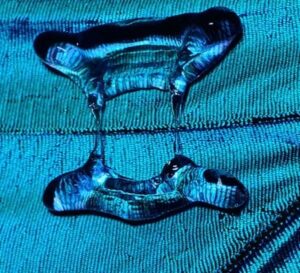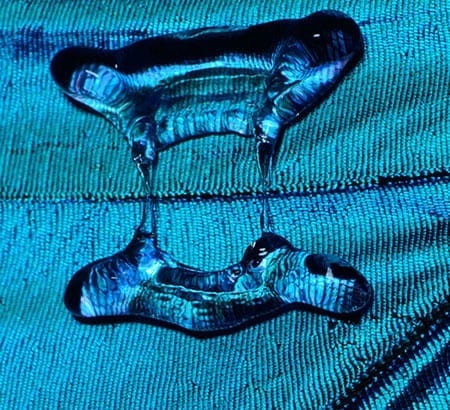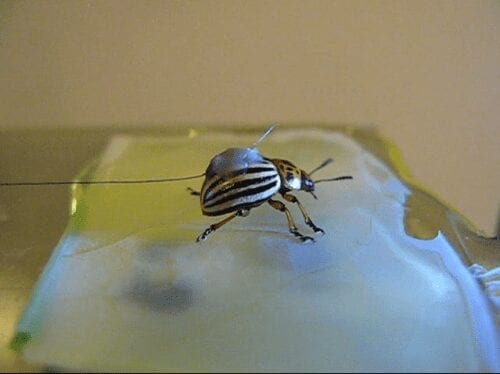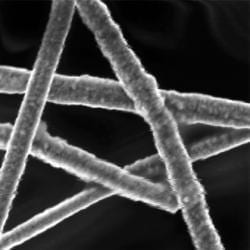
Scientists may have just created the most water-resistant artificial material in the world.
A surface’s texture makes all the difference when it comes to water resistance. Ridged, veined surfaces — like the wings of a butterfly — cause drops to break into irregular shapes, dramatically reducing their contact time. This finding could lead to new technologies for anything that involves dynamic interactions of liquids onto solids — such as wind turbines or flying robots.
Many of those who study hydrophobic materials — water-repellant surfaces in both nature and laboratories — had found themselves at an impasse with a theoretical limit on the amount of time it takes for water to rebound from a surface. However, a team of researchers have achieved a breakthrough: They found a way to reduce a water droplet’s contact time with a surface by 40 percent or more.
The researchers — Kripa Varanasi, Doherty associate professor of mechanical engineering at Massachusetts Institute of Technology; James Bird, assistant professor of mechanical engineering at Boston University; former MIT postdoc Rajeev Dhiman; and MIT PhD recipient Hyuk-Min Kwon — reported their findings in the journal Nature.
Contact Time
The theorized limit of the minimum time a drop stays in contact with a surface is based on the time frame of oscillations in a drop. It was previously believed that minimizing interaction between the water and surface was the key to achieving the theoretical minimum contact time. The thinking was that water rebounded fastest when hitting a smooth surface in a symmetrical shape.
However, the MIT team found that increasing surface interaction time in a certain way could lower contact time beyond that theoretical limit. By adding macroscopic features like ridges that split droplets, the scientists were able to cause the water to rebound in uneven, irregular shapes and reduce contact times by 40 percent.
Frozen Aircraft
The breakthrough could have tangible applications in critical environments — possibly to prevent ice buildup on aircraft by repelling rain before it had a chance to freeze. The researchers showed in findings that the droplets bounced off the modified surfaces before freezing, where they would solidify on control surfaces.
The team believes that the contact time can be lowered still, to a 70-80 percent reduction on the original limit, by optimizing the ridged texture. The ridges used in the surface textures can be created using regular milling tools.
“We showed the effect with simple ridges, but we could think of other macroscopic geometries as well,” MIT’s Varanasi told TechNewsWorld.
“Perhaps the most straightforward [way to further reduce contact time] would be to design the texture to fracture the drop into more pieces,” Boston University’s James Bird told TechNewsWorld.
For example, “instead of having the drop fall on a one-dimensional ridge, have the drop fall on a grid, or perhaps many crisscrossing ridges,” he suggested. “Reducing the distance that the film needs to retract to come off the surface will shorten the contact time.”
Butterfly Wings
While conducting the research, the team found a number of surfaces could replicate the uneven breakup of droplets, as long as the ridges were of the correct scale.
Some butterfly wings, for instance, replicate the effect, allowing the creatures to avoid water clogging down their aerodynamic capabilities and effectively improving their chances of survival. Veins in wings act as the water-breaking ridges for the butterflies. Likewise, the leaves of plants in the nasturtium genus have veins on top of their leaves, which break up drops.
The Latest Google Headlines on:
Hydrophobic materials
[google_news title=”” keyword=”hydrophobic materials” num_posts=”10″ blurb_length=”0″ show_thumb=”left”]
The Latest Bing News on:
Hydrophobic materials
- Is Water Wet? The Answer is Surprisingly Elusiveon April 26, 2024 at 12:02 pm
It depends on the properties of water, the definition of wetness, and whether you can trust when your senses inform you if something is wet or not.
- Fly Fishing and Our Environment: PFAS Are Being Canceled, Why Is This a Good Thing?on April 26, 2024 at 10:57 am
PFAS are common in fly fishing apparel and gear. Why are they being prohibited by law? As of January 1, 2025, California will prohibit the manufacture, sale and distribution of all textiles that ...
- Mask-inspired perovskite smart windows enhance weather resistance and energy efficiencyon April 25, 2024 at 6:36 am
Thermochromic perovskite is a new color switch material used in energy-saving smart windows. Despite its potential for energy savings, thermochromic perovskite suffers from poor weather resistance, ...
- Reducing embodied carbon in concrete constructionon April 25, 2024 at 12:15 am
Mixing water-repelling pore blockers with concrete helps minimize a project’s carbon footprint while maximizing the lifetime of new construction.
- New Physics at Play: Physicists Discover a New Force Acting on Water Droplets Moving Over Superhydrophobic Surfaceson April 20, 2024 at 9:13 pm
Researchers at Aalto University have discovered a new force acting on water droplets moving over superhydrophobic surfaces like black silicon by adapting a novel force measurement technique to uncover ...
- Hydrophobic Coatings Market Size to Reach US$2.6 Bn in 2031, up from US$1.8 Bn attained in 2024on April 18, 2024 at 7:36 am
Poised to Record Sales of US$2.6Bn in 2031, Global Hydrophobic Coatings Market is Forecasted to Secure a CAGR of 5.39% Attributed to the Increasing Infrastructure Development and Expanding Electronics ...
- BVI Launches PODEYE Hydrophobic Monofocal IOL in Japanon April 17, 2024 at 6:59 pm
Second BVI Market Debut in Less Than Twelve Months BVI continues to execute its roadmap of IOL launches in Japan, the world's third-largest IOL-valued market1The PODEYE hydrophobic monofocal is ...
- Physicists explain, and eliminate, unknown force dragging against water droplets on superhydrophobic surfaceson April 16, 2024 at 7:18 am
Microscopic chasms forming a sea of conical jagged peaks stipple the surface of a material called black silicon. While it's commonly found in solar cell tech, black silicon also moonlights as a tool ...
- New Understanding of Metallopolymers Could Improve Materials Recyclingon April 14, 2024 at 5:00 pm
“We found that solvation does indeed play a role: PVFc, the more hydrophobic polymer ... guide the development of better systems that involve ion separations such as materials recycling and metal ...
- Researchers study effects of solvation and ion valency on metallopolymerson April 13, 2024 at 3:54 am
In a new paper published in JACS Au, researchers at the University of Illinois Urbana-Champaign analyzed the effects of solvation and ion valency on metallopolymers, with implications for critical ...
The Latest Google Headlines on:
Water-resistant artificial material
[google_news title=”” keyword=”water-resistant artificial material” num_posts=”10″ blurb_length=”0″ show_thumb=”left”]
The Latest Bing News on:
Water-resistant artificial material
- Scientists create octopus-inspired ‘super strong’ robotic suction cupson April 27, 2024 at 8:00 pm
“The most important development is that we successfully demonstrated the effectiveness of the combination of mechanical conformation - the use of soft materials to conform to surface shape, and liquid ...
- Neoprene Bags from Amazon That You Should Buy Nowon April 26, 2024 at 4:08 pm
Looking for a new bag that’s functional without sacrificing style? Check out these Neoprene bags you can get right on Amazon! I’ve put together a list of some of ...
- Textile pollution: What is it, why it’s problematic and what must be doneon April 26, 2024 at 4:59 am
Textile pollution is a problem in South Africa but there are solutions to dealing with the challenges it presents ...
- Cellulose-based components mass produced with AP&T press lineon April 25, 2024 at 1:32 pm
To industrialize their manufacturing process, the company contacted AP&T in 2020. “We turned to AP&T for numerous reasons – primarily, because it is a Swedish company with solid experience of meeting ...
- The Best Blankets For Snuggling Anytime: Our Tested Roundupon April 25, 2024 at 7:01 am
It’s made of ripstop nylon, so it’s lightweight and water-resistant ... What is the softest blanket material? Softness is a tricky metric to measure objectively, but micro-plush fleeces and synthetic ...
- Try dark shades for a thrilling Louisiana gothic garden designon April 24, 2024 at 8:57 am
The late 19th and early 20th centuries saw a push against the industrial revolution with gardens that favored traditional craftsmanship and the garden with the home. This encouraged the design of ...
- MIT Technology Reviewon April 24, 2024 at 1:59 am
A world powered by electricity from abundant, renewable resources is now within reach.
- This Earth Day, Upgrade Your Heels For Luxury Vegan Footwearon April 22, 2024 at 11:01 am
What makes footwear sustainable? Most people assume that means they’re made from vegan leather—but oftentimes faux leather can be even worse for the planet than the real deal, since they may be ...
- Expert-approved Caribbean Cruise Packing Liston April 19, 2024 at 3:00 am
An expert cruise writer shares what to pack before you set sail for your next tropical vacation with Royal Caribbean, including swimsuit coverups, sun dresses, waterproof phone cases, luggage tag ...
- How to stop ‘forever chemicals’ from lasting, well, foreveron April 18, 2024 at 2:32 pm
PFAS are used in consumer goods from carpets to rain jackets, from cookware to cosmetics. They are resistant to heat, and repel stains, oil, and water, but they do not break down in nature. And they ...











